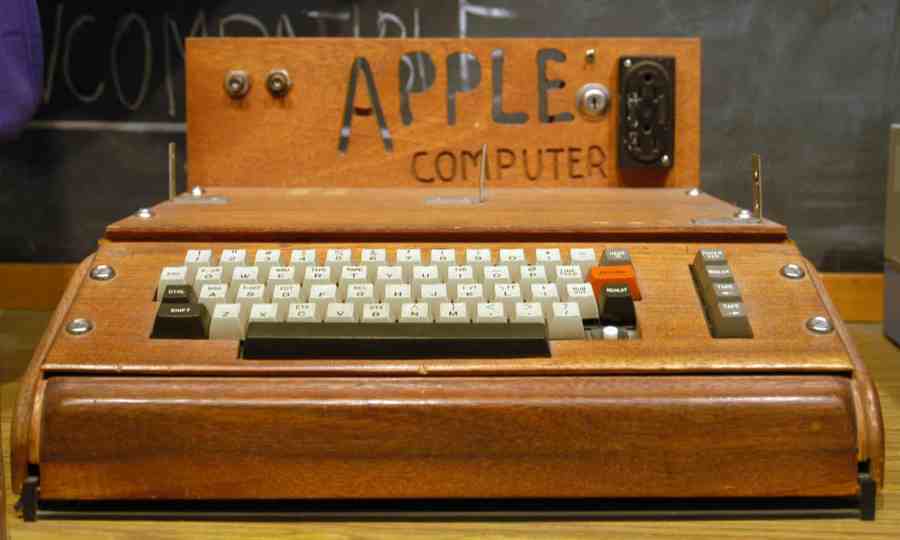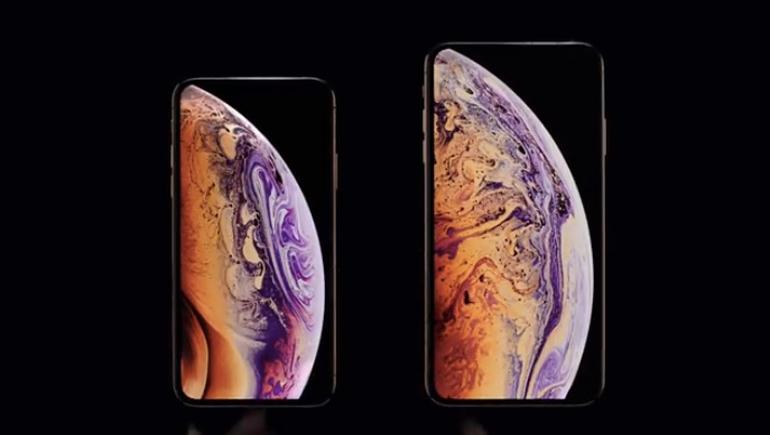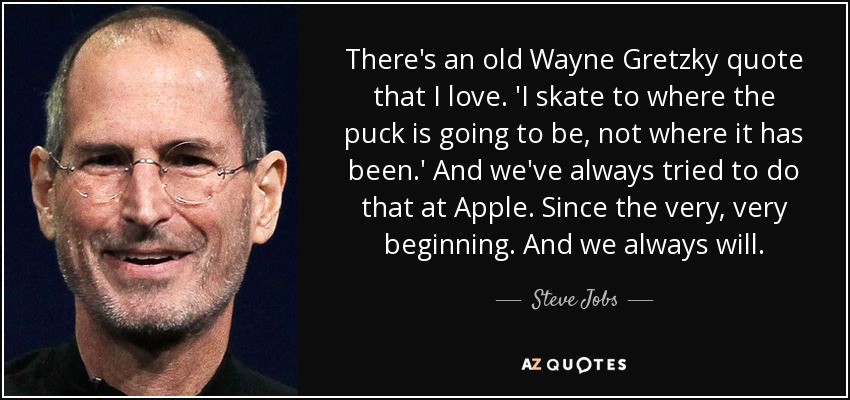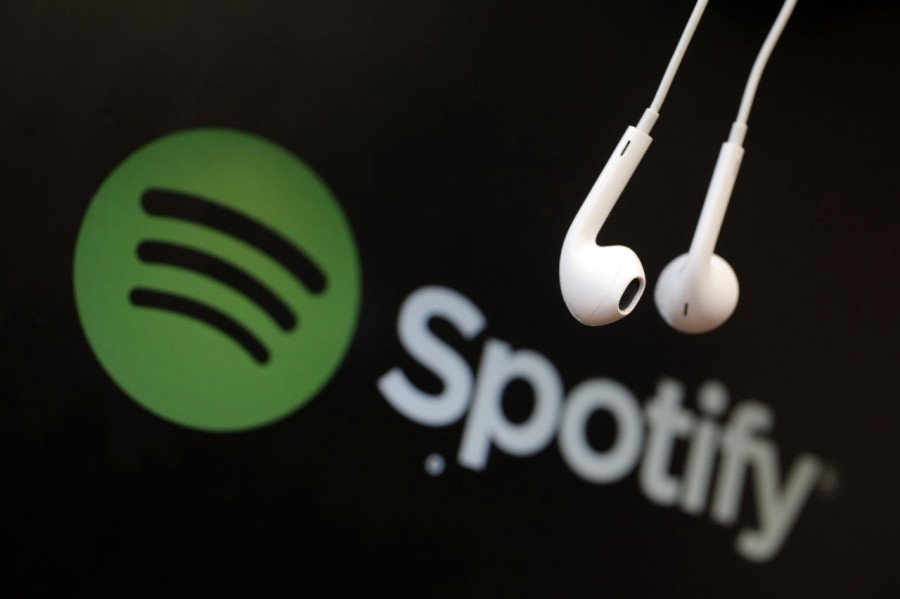My last blog post discussed hmv’s inability to adapt in the ever changing landscape of entertainment consumption. So, it’s only fitting that for this post, I will be discussing a company who (among others) were responsible for that downfall. A company who’s evolution over the years and constant ability to crash through barriers enables them to continually disturb conventional ways of thinking. A company who approached your average hmv consumer who was struggling under the weight of a hundred CDs and cursing the AA batteries in their CD walkman and said: “we can fit 1000 songs, in your pocket”.
The evolution of Apple

Progression and moving forward are concepts that sit at the core (sorry, couldn’t resist) of Apple’s business model. Fundamentally though, Apple made products, computers… things; they operated in the physical space. The first Apple computer was released in 1976 and various models followed until the model that really combined Apple’s expertise at designing beautiful machines with the internet was born, the iMac was released in 1998. The idea behind the iMac was to give internet access to the ‘low-end’ market and was a huge step towards bringing the digital world, a space which was rapidly evolving by this point, into our lives permanently.
The digital Apple

It may sound simplistic to say but this thing we call ‘digital’, isn’t a thing at all. It’s actually the opposite of a thing. The fact that there isn’t a physicality to digital put the nail in the hmv coffin because they weren’t able to sell it in their stores. What Apple did, and continue to do, so well are two things: 1. Grant us access to the digital world. 2. Fill the digital world with incredible things.
So let’s break down those two services.
Access to the digital world

As I established earlier, Apple were one of the companies to make access to the internet available in a tight, compact and sleek personal computer. They were responsible for creating the iPod which revolutionized the way we consume music and they practically invented what we expect from a smartphone today. All of these tools are gateways into the digital world like the internet, digital photography, digital music, apps etc. Apple predicted the importance of digital and not only supported it but ran with it to the extent of pushing it further.
Filling the digital space

It is here that Apple’s true genius shows.
In the late 1990’s and early 2000’s, mp3s were gathering speed and importance in the digital space and “In January, 1999, ‘MP3’ became the pre-Google internet’s top search term, overtaking ‘sex.’” (Hill 2013), it really was a jungle out there with peer-to-peer file sharing and illegal downloading; but it couldn’t last and it didn’t. The record labels started acting and bit by bit, the illegal file sharing flurry of the early 2000’s began to crumble and iTunes rose up as the legal solution.
Apple had invented the perfect device for listening to music on the go in 2001 and then iTunes was available to all in 2003. By the mid 2000s, Apple were running the game of digital music both in terms of the physical product and the digital music marketplace but there was another wave of change on the horizon…
Diversify… Spotify.

It was in 2006 that the world of digital entertainment changed again.
Spotify were coming to change the game and after launching in 2006, announced two million paying subscribers in 2011(Lidsky 2018). While it had only been around for less than 10 years, the business of digital music was changing again and it was a big one; people no longer wanted to pay for downloads, they wanted to move to a subscription model and stream their music.
So what did Apple do? They launched their own streaming service, Apple Music, in 2015 and as of November 2018, had 56 million paying subscribers. Although it is worth noting that Spotify has a far superior 83 million paying subscribers in the same year (Gartenberg 2018), you cannot fault Apple’s ability to develop, challenge and stay relevant in a marketplace which only really was invented less than 20 years ago.
So what now?
So Apple diversified their offering from iTunes to Apple Music to compete with the streaming services and now what? It seems as though Apple are following the footsteps of fellow streaming giants, Netflix, into the world of content creation and further improving their offering in the digital world (Leskin 2018) but when the next phase of digital entertainment comes to wipe streaming off the map, guess who’s got my money to evolve and remodel to move with the times?
References
Gartenberg, C. 2018. Spotify Hits 83 Million Paid Subscribers. The Verge. Accessed: https://www.theverge.com/2018/7/26/17616404/spotify-paid-subscribers-83-million-streaming-music-quarterly-results
Gibbs, S. 2016. The Guardian. 40 Years Of Apple – In Pictures. Accessed: https://www.theguardian.com/technology/gallery/2016/apr/01/40-years-of-apple-in-pictures
Glazer, J. 2018. NDC San Diego. 40 Years of Apple: A Look Back at Apple Product Evolution. Accessed: https://www.nbcsandiego.com/news/tech/Apple-Products-Through-the-Years-374175161.html
Hill, B. 2013. Engadget. The iTunes Influence, Part One: How Apple Changed The Face Of The Music Marketplace. Accessed: https://www.engadget.com/2013/04/29/the-itunes-influence-part-one
Lidsky, D. 2018. Fast Company. The Definitive Timeline Of Spotify’s Critic-Defying Journey To Rule Music. Accessed: https://www.fastcompany.com/90205527/the-definitive-timeline-of-spotifys-critic-defying-journey-to-rule-music
Leskin, P. 2018. Business Insider. Apple’s Original TV Shows And Movies Could Be Free For All iPhone and iPad Owners With The Launch Of Its New Video Streaming Service. Accessed: https://www.businessinsider.com/apple-plans-to-make-its-original-content-free-for-all-iphone-and-ipad-owners-2018-10?r=US&IR=T
Hi Sam
A great post and interesting reading. I find it incredible how Apple are continuing to evolve themselves to meet the latest trends and changes in the market place.
The part of the blog that really fascinated me was about Apple creating a video streaming channel like Netflix. I hadn’t heard this so I did a bit of research and apparently they have lots of high profile stars and directors, working on various TV shows. It looks like the 25th March 2019 is when the channel will be unveiled with a release date in the autumn. I thought you might be interested in is article, which was written yesterday, which lists some of the film/documentary projects they are working on. https://www.macworld.co.uk/news/apple/apple-streaming-service-3610603/
Whist I applaud Apple’s diversity into different digital markets, do we really need another video streaming service, what are your thoughts?
And finally, where you’re putting your money? I’m guessing Apple, I think I’ll join you on that…..:)
Regards
Gayle
LikeLike
Hi Sam! Another great post…once again 😉
It’s really eye-opening how – after this weeks module work – you pointed out how adaptable apple as a business model is. Once their is a new technology/product on the market, apple was always ready to adapt as soon as possible. That’s a masterly performance regarding business structure. I immediately had to look the companies structure up and found out that the business strucutre combines product-based devisions with a weak functional matrix, as Meyer (2019) states. ” In a weak functional matrix, top management determines project direction, while project heads have limited authority and control. For example, the corporate structure allows hardware teams to collaborate with software teams.” (Meyer,2019). I think this plays a huge role regarding apples ability to constantly adapt and innovate. It seems like Tim Cook permanently has the ability to play and relocate all the company’s “division-building blocks”. Additionally, I just remembered Jim Hemerling’s (2016) TED Talk about 5 ways to lead in an era of constant change. I think all of his 5 points – Purpose, People, Culture, Capability and Inclusive – fit apple perfectly! You may want to check out this Fast Company interview with apple CEO Tim Cook: https://www.fastcompany.com/40525409/why-apple-is-the-worlds-most-innovative-company
Here he is giving some insights into the company culture, explaining that it’s all about people and products! What do you think causes apples ability to innovate and adapt so perfectly? Would love to hear your thoughts!
Kindest regards,
Max
Sources:
– http://panmore.com/apple-inc-organizational-structure-features-pros-cons
– http://panmore.com/apple-inc-organizational-structure-features-pros-cons
LikeLike